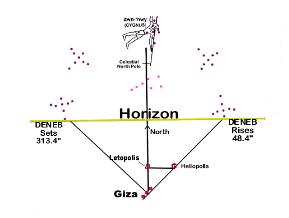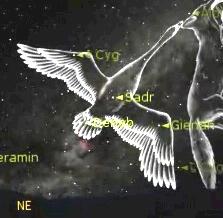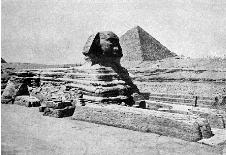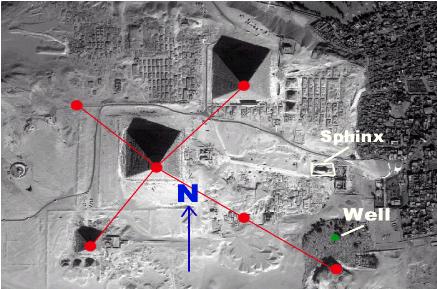 |  | |||
Above: Cygnus—the celestial bird, as it rose at Giza in 2600 BC. | ||||
Above— In 2600 BC at Giza Cygnus rose to the NE and set in the NW. | ||||
 | |||||||||
Has Andrew Collins Found the Entrance to the Hall of Records at Giza? Was Giza Constructed to Depict the Constellation of Cygnus? by Dr. Greg Little | |||||||||
Above—the right side of the Sphinx with the Great Pyramid in the background. | |||||||||
British science writer Andrew Collins has authored several of the most intriguing books ever published on ancient mysteries. His best-selling 1997 book, From the Ashes of Angels, traced the beginning of civilization to an area near Lake Van in Turkey where a mysterious group of people called the Nephilim appear to have lived around the end of the last Ice Age. Collins latest book published in November 2006 in the UK, The Cygnus Mystery, is in many ways a follow-up to all of his prior books and begins at Gobekli Tepe in Turkey. There, Collins was faced with the oldest temple structures known to exist anywhere in the world. The enigmatic underground temples at Gobekli Tepe are dated to 11,500-years ago. Collins came to understand that all of the temples at Gobekli Tepe were oriented to the North. This finding led him to evaluate important archaeological sites in the Americas, India, China, Europe, and Egypt. He concluded that the earliest religions of the world venerated the constellation of Cygnus, which is located at the Great Rift in the Milky Way. Cygnus is typically depicted as a swan or other bird and is shown in the oldest cave art in the world. Rituals performed at various American mounds, at Maya and Inca sites, at stone circles in Europe, and in Egypt appear to have been done with the idea that Cygnus was seen as the portal of souls to and from the sky world. Orion or Cygnus? Some years ago it was suggested that the three large pyramids at Giza were built to represent the stars of Orion's belt. This idea was exciting and new at the time, but as many have shown, the three stars of Orion's belt don't precisely fit over the three pyramids nor are the pyramids aligned in the same way as the constellation of Orion is seen in the sky. As Collins came to see that Egyptian religious beliefs incorporated Cygnus into their system, he was surprised to find that the three center stars of Cygnus actually fit precisely over the three pyramids of Giza. He also discovered that in 2600 BC the main star of Cygnus, called Deneb, rose on the NE horizon in perfect alignment with the three pyramids and the ancient site of Heliopolis. Then he found that Deneb set on the NW horizon in 2600 BC. It was clear that Giza was erected to somehow venerate Cygnus. The Hall of Records Entrance. Visiting Egypt to carefully examine the relationship between Cygnus and the Giza monuments, Collins was eventually led to a sacred well in a limited-access Muslim cemetery at Giza. The well, called Beer el-Samman, is located about 300 yards south of the right front paw of the Sphinx. A village elder told Collins that the well was "the entrance to Giza's Duat-underworld." The well is a carefully-formed, brick-lined, deep artisan well still used today and there is evidence that blocked passages lie at its base. Interestingly, if the remaining stars of Cygnus are placed over Giza, all of them fall on sacred sites at Giza. The star forming the mouth of the celestial bird Cygnus, Albiero, lies at Gebel Ghibli, the sacred knoll south of the Sphinx, quite close to the well of Beer el-Samman. The correspondence between the idea that the well is the entrance to the underworld and its location at the mouth of the celestial bird Cygnus is intriguing. The famed American psychic, Edgar Cayce, told of a Hall of Records at Giza, which was located somewhere underground between the Sphinx and the Great Pyramid. However, Cayce's description of the entrance to the Record Hall was that it was between the right paw of the Sphinx and the Nile, on a line from the Great Pyramid. Curiously, Collins' discovery of the well at Gebel Ghibli closely fits Cayce's description. | ||
 | ||
Above—the stars of Cygnus as they fall on Giza. The three main central stars fit on the three pyramids precisely while the Orion alignment that has been previously suggested doesn't. Note the location of the well is to the south, off the right paw of the Sphinx. | ||
 | ||||
 | ||||
The Illustrated Encyclopedia of Native American Mounds & Earthworks — by Dr. Greg Little | ||